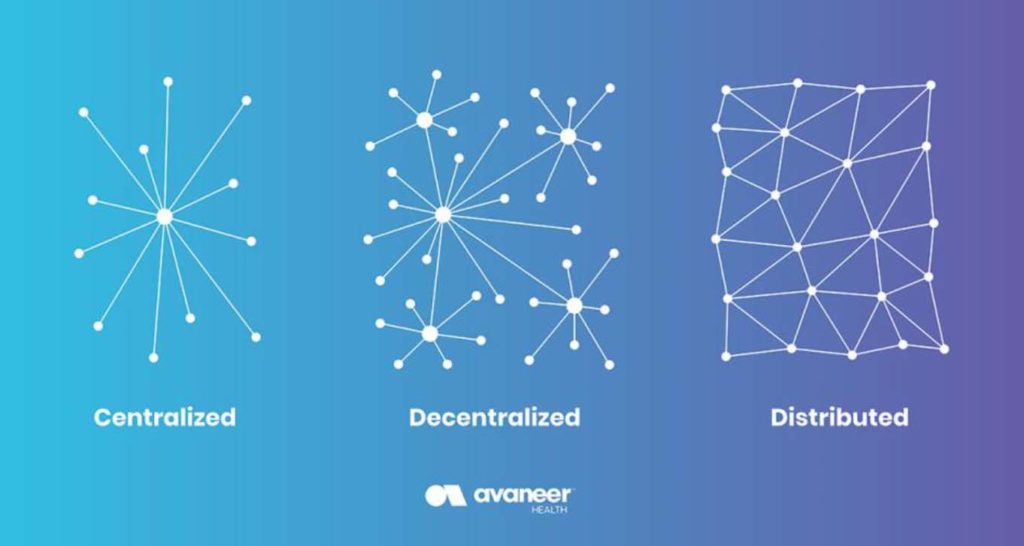Mitigating Cybersecurity Events with a Decentralized Network
Ransomware attacks like the one that happened to Change Healthcare in February of 2024 have grown more frequent in healthcare, with 460 attacks in the U.S. in 2023. According to the Department of Health and Human Services, threat actors have become increasingly aggressive in the healthcare sector, targeting both “known and unknown weaknesses in a victim’s environment.” The U.S. Department of Health and Human Services (HHS) suggests ransomware generally moves laterally throughout a network so segmentation can help limit its impact by containing the event within a single segment. This built-in segmentation is one of the benefits of a decentralized network.
What is a decentralized network?
Typical system architectures are designed with a central server through which all information and actions are processed. Conversely, decentralized networks are designed to use multiple distributed nodes, each acting in the same capacity as a central server while still managing its own information and connecting with other nodes.
In a decentralized architecture, if any single node on the network encounters an issue, it can be taken offline or isolated.
How does a decentralized network work?
On a decentralized network, participants have their own private, secure cloud-hosted environment. It’s populated with a prepackaged suite of utilities and services that connect, collaborate, and transact directly with other participants on the network. This eliminates the need to establish and maintain multiple single-use, point-to-point connections.
A decentralized network enables data to be securely shared, with the appropriate permissions, between participants without exposing the data to an intermediary. Because the data is not centrally aggregated, it remains in the control of each participant. Though the network provides an auditable record of data exchange between participants, the network itself never stores or accesses the data.
A decentralized network eliminates the need to deal with numerous custom, proprietary integration requirements for APIs and third-party platforms.
The benefits of a decentralized network
On a decentralized network, participants control how, with whom, and for what purpose data is exchanged. In this way, a decentralized network speeds the rate of data exchange while keeping data secure between all network participants. Other benefits include the following:
- Provides increased data integrity, immutability, and traceability.
- Enables data originators to control who has access to their data and how and when it can be accessed.
- Data is always available when and where it’s needed without having to be requested, aggregated, and validated.
- Data can be provided in any format or standard, and normalized when used on the network
- Participants experience a reduced need to manage multiple interfaces and stand-alone connections.
- As the network grows, data becomes more valuable.
- Due to its design, participants can leverage the network for unlimited use cases.
How Avaneer Health’s decentralized network is different
Avaneer Health’s robust data governance model is a primary pillar of the Avaneer NetworkTM and platform. The network’s decentralized architecture ensures that participants always remain in control of how, when, and by whom their data is accessed. Solutions available on the network are installed to each participant's network environment, eliminating the need to send their data to someone else’s cloud.
Unique capabilities of the Avaneer Health Network
- Bring your own key. Participants can maintain adherence to their organization’s security requirements by bringing their own encryption keys to the Avaneer Network, ensuring their data is under their control.
- Access control. Attribute-based access controls (ABAC) and configurable authorization controls enable participants to control what data is exchanged with their trading partners.
- Secure environment. Network participants receive a private, secure environment provisioned with HIPAA-compliant health data storage and communication services.
- Localized and in the cloud. Applications offered on the Avaneer Network are localized and operate where the data is stored.
- Transparency in data access. All network activity is HIPAA-compliant, logged, and auditable.
- Deny-by-default security architecture. No communication to any other participant or any Avaneer Health service is allowed unless explicitly turned on by the owner, providing security throughout the data layer, networking layer, and application layers.
A decentralized network in action: Avaneer Coverage Direct
One of healthcare’s most onerous, error-prone administrative processes is determining patient insurance coverage. Issues in this process can lead to denials, delayed reimbursement, write-offs, and surprise patient bills. Avaneer Health is simplifying the entire process with Avaneer Coverage DirectTM by giving payers and providers near real-time coverage information that is always accurate, up to date, and available within their environment.
Because the Avaneer Network has a decentralized architecture, when any change is made to a member’s/patient’s coverage data, Avaneer Coverage Direct automatically determines missing, conflicting, and incorrect coverage details, and immediately updates all permissioned payers and providers on the network. In this way, Avaneer Coverage Direct increases transparency and data accuracy, without the data having to be sent or accessed outside of the network.
Because the Avaneer Health network is decentralized, payers and providers always retain control over their data; Avaneer Health does not see or store the data that is shared between participants.
Avaneer Health’s decentralized network allows payers and providers to share coverage and other types of transactional data without having to hand it over to clearinghouses and other third-party vendors and without having to build and maintain multiple, complex, single-use connections. Patient data is kept safely within the network.
The time to act is now
Cybercrimes targeted at healthcare systems are on the rise and organizations need to do all they can to prevent and protect against these threat actors. Decentralized networks can play a key role in doing just that.
Want to learn more about Avaneer Health? Contact us.
